
In other stores, shoppers will arrive looking for products that are of regional importance and leave dissatisfied. The problem with this approach is that, in reality, the average plan will only be perfectly suited to the average stores. When retailers are generating planograms for hundreds of stores, it's tempting to create an "average" space plan that balances regional differences then distribute that layout to every store. One Plan Does Not Fit All: Enabling a Customised Approach In order to shift their view of planograms from a micro to a macro perspective, there are a few key points retailers need to consider:

What could be more important?īy taking a higher level approach to space planning, retailers can achieve increased sales and a competitive edge in every market.

Planogram creators are the unsung heroes who ensure that, when shoppers enter their stores, they find the products they're looking for. When retailers are investing in major ad campaigns, opening new stores or launching trendy private-label products, it can be difficult to focus on the efforts of planners to generate highly detailed planograms a complex activity that often resembles putting a jigsaw puzzle together.īut the truth is that space planning is one of retailers' most critical activities. Space planning is an activity that occurs quietly, without much fanfare or acknowledgment.

By Ralph Williams, Practice Director, Strategic Services, JDA Software.


 0 kommentar(er)
0 kommentar(er)
